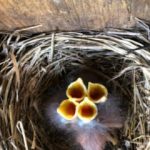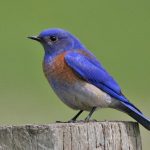Prescott Bluebird Recovery Project (PBRP)
The Prescott Bluebird Recovery Project is a 501 (c)(3) nonprofit volunteer organization dedicated to the recovery, restoration, and enhancement of the Western Bluebird. The Western Bluebird is listed as a “sensitive species” in Oregon by the Oregon Department of Fish & Wildlife. Since the 1970’s the PBRP has been working to help restore the Western Bluebird in portions of Clackamas, Marion, Multnomah, Washington, and Yamhill counties. Click for map of monitored areas. The major reasons for the decline of the Western Bluebird are: loss of habitat; competition from non-native house sparrows and starlings; and reduction of insects due to the use of pesticides.
PBRP volunteers are involved in the following activities:
Nest Boxes: Volunteers place, monitor, and maintain nest boxes constructed to PBRP’s specifications. Boxes are in appropriate habitat that meets the needs of the bluebirds and where pesticides are not generally used. Monitors help guard against the non-native European House Sparrows and Starlings; these aggressive birds compete for nest sites and often kill native Western Bluebirds.
Data Collection: During the nesting season, volunteers gather valuable nesting information which is entered into the PBRP database. Data collected includes the number of nesting attempts, eggs, hatchlings, and fledglings. The PBRP database contains over 25 years of Western Bluebird nesting data. In 2023, 61 volunteers monitored over 750 nest boxes.
Click here for 5 years of nesting data.
Data Sharing: PBRP shares its data with researchers engaged in important bird population research. Why is this important? A study led by Cornell Labs in 2019 reported a staggering loss of 2.9 billion breeding pairs of adult birds in the U.S. and Canada. In 2022 the American Bird Conservancy released its State of the Birds Report, noting half of the U.S. bird populations are declining. Here locally in Oregon, PBRP data is being used by OSU Professor Suzanne Austin. For more about her research, read an overview in our Fall 2023 newsletter or visit her website.
Education: Volunteers educate landowners and the general public through articles, training, and presentations.
We are making a difference. Since reaching an all-time low in the early 1970’s, the Western Bluebird population in the northern Willamette Valley has increased due in large part to the dedication of our volunteers. Where it took Hubert Prescott 6 years in 1965 to locate a bluebird, bluebirds can now be seen nesting along our rural roadways, in cemeteries and golf courses, in vineyards and orchards, and on many private rural properties.




